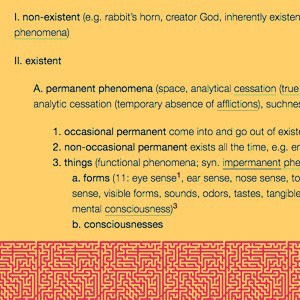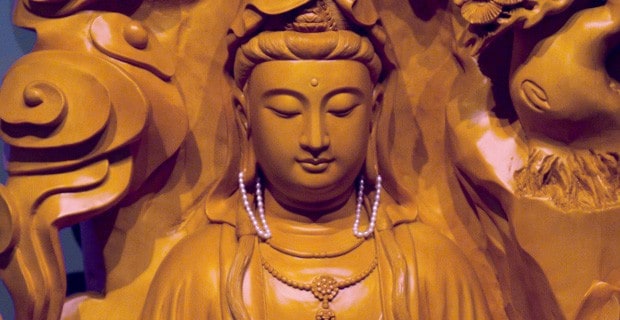Divisions of the selfless

This chart shows the divisions of all phenomena into various categories according to the Buddhist Sautrantika tenet school. This division of phenomena is part of the Collected Topics literature that is learned as the foundation for Buddhist debate and reasoning.
I. non-existent (e.g. rabbit’s horn, creator God, inherently existent self of persons and phenomena)
II. existent
A. permanent phenomena (space, analytical cessation (true cessations), non-analytic cessation (temporary absence of afflictions), suchness or emptiness)
- 1. occasional permanent come into and go out of existence
2. non-occasional permanent exists all the time, e.g. emptiness, space
3. things (functional phenomena; syn. impermanent phenomena)
a. forms (11: eye sense1, ear sense, nose sense, tongue sense, body sense, visible forms, sounds, odors, tastes, tangible objects2, forms for mental consciousness)3
b. consciousnesses
- 1. (primary) minds (6: visual, auditory, olfactory, gustatory consciousness, tactile, mental ) Meditation on Emptiness p. 232
2. mental factors
-
a) omnipresent mental factors (5: feeling, discrimination, intention, contact, attention)
b) object ascertaining mental factors (5: aspiration, belief, mindfulness, concentration, intelligence)
c) virtuous mental factors (11: faith, integrity, consideration for others, non-attachment, non-hatred, non-ignorance, effort, pliancy, conscientiousness, equanimity, non-harmfulness)
d) root afflictions
-
1′: attachment
2′: anger
3′: pride
4′: ignorance
5′: deluded doubt
6′: afflicted views (5: view of personal identity, extreme views, holding wrong views as supreme, holding bad ethics and modes of conduct as supreme, wrong views)
e. secondary afflictions (20: wrath, resentment, concealment, spite, jealousy, miserliness, pretension, dishonesty, complacency, harmfulness, non-integrity, inconsideration for others, dullness, excitement, laziness, non-faith, non-conscientiousness, forgetfulness, non-introspective awaremess. distraction)
f. changeable mental factors (4: sleep, regret, investigation, scrutiny)
c. abstract composites
- 1. person
2. non-person compositional factors (23: acquisition, absorption without discrimination, absorption of cessation, one having no discrimination, life faculty, similarity of type, birth, aging, duration, impermanence, group of stems, group of words, group of letters, state of an ordinary being, continuity, distinction, relatedness, rapidity, order, time, area, number, collection)
Pot is a tangible object. It appears to an eye consciousness and an eye consciousness sees it, but it’s not an object of apprehension of the eye consciousness. The objects of apprehension of eye consciousness are color and shape of pot. (Meditation on Emptiness p.225) Pots are matter and are forms, but are not visible forms, form-constituents, form-sources. They are tangible object, tangible object constituents, and tangible object sources. ↩
Eight atoms are tangible object. Without touch we can’t experience their functions of hardness, heat, wetness, moving. (Meditation on Emptiness p.232) ↩
Forms for mental consciousness are in form aggregates, but are phenomena sources, e.g. form arising from aggregations (e.g. single particles); space forms (blueish space that appears to eye consciousness is a visible form, but the space that appears to a mental consciousness is a form for mental consciousness, both are impermanent); forms arising from promises (e.g. vows which are non-perceptible forms); imaginary forms (dreams objects, bones in meditation on bones); forms for one with meditative power (objects of meditation that exist in fact—some of these can be shown to another person’s eye consciousness, such as fire and water produced by samadhi). ↩
Venerable Thubten Chodron
Venerable Chodron emphasizes the practical application of Buddha’s teachings in our daily lives and is especially skilled at explaining them in ways easily understood and practiced by Westerners. She is well known for her warm, humorous, and lucid teachings. She was ordained as a Buddhist nun in 1977 by Kyabje Ling Rinpoche in Dharamsala, India, and in 1986 she received bhikshuni (full) ordination in Taiwan. Read her full bio.


